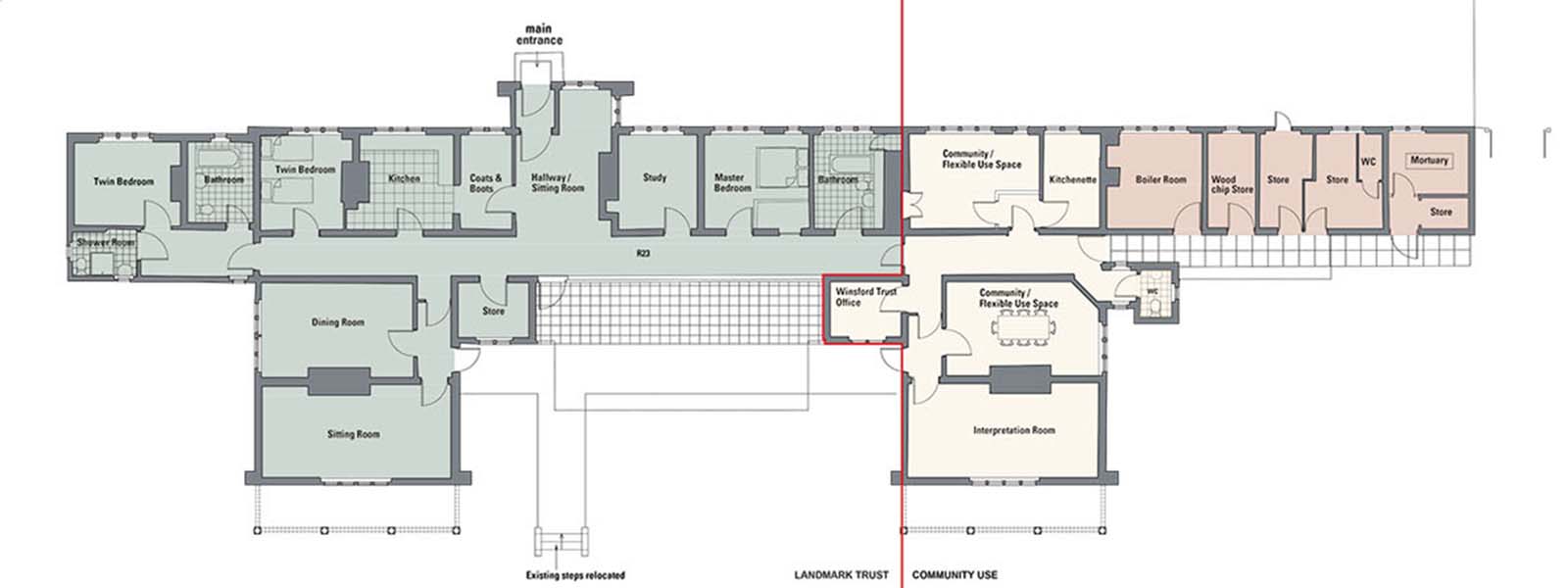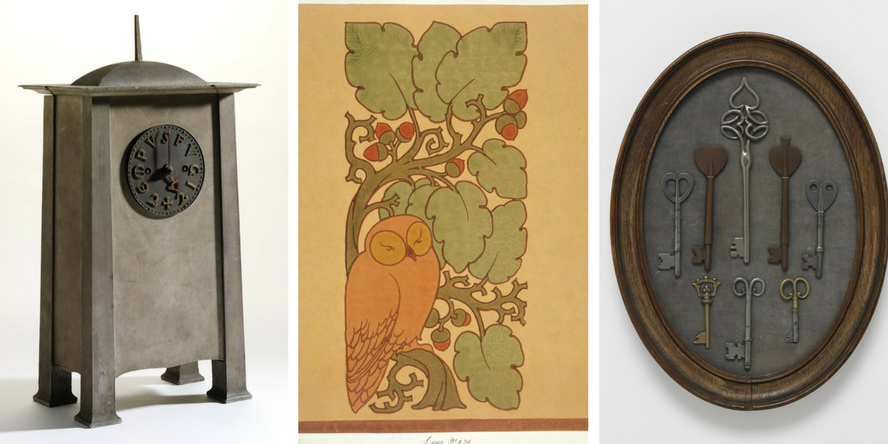Voysey's only hospital, now at risk
Designed by the brilliant Arts and Crafts architect C.F.A. Voysey, Winsford Cottage Hospital is a unique example of an unaltered, purpose-built Victorian cottage hospital.
Grade II* listed, it has been on the Heritage at Risk register since 2009 and is declining daily.
Once restored, the main spaces of the building will become a comfortable and welcoming Landmark for six, while four rooms in the east wing will be set aside for community use.
Help us raise £179,500 in the next 9 months, to save this building.
A building that inspired love and affection
The hospital was a gift to the local community from wealthy philanthropist Maria Medley, in memory of her husband George. It served the community as a hospital for nearly a century, inspiring huge love and affection, before finally closing its doors in 1998.
Winsford tells the story of health provision in the 20th century, from the treatment of wounded soldiers from the Front during the First World War, to the creation of District Nurses, the development of maternity units and the establishment of the NHS in 1948. For the last 18 years it has been in the ownership of a small charitable trust, who came to Landmark for help in finding a sustainable future for this much loved place.
The building is an architectural gem, designed by C.F.A. Voysey in one of the most prolific and successful years of his distinguished career. It includes many of the characteristic features found in Voysey's country houses - beautiful but understated architectural motifs, hearts, birds and trees, perfectly detailed window fittings and door furniture. Remarkably, many of these survive intact, yet this building stands in a critical condition.

We are delighted to have the support of the Heritage Lottery Fund for the rescue of Winsford Cottage Hospital. The HLF has awarded a grant of £96,000 to develop the project, with the opportunity to apply for a further £487,000, if we can raise the rest of the funding ourselves.
-
£25 will restore 200 pieces of original mosaic floor
Donate £25
-
£50 buys three m² of sheep's wool insulation
Donate £50
-
£275 will repair one of Winsford's seven chimneys
Donate £275
A place that transformed the lives of ordinary people
The advent of the cottage hospital in the 19th century transformed the lives of hundreds of thousands of people. One of the very finest was the Winsford Cottage Hospital in Devon.
Built by wealthy philanthropist Maria Medley as a gift to the local community, it enabled ordinary people to receive affordable medical treatment near to their homes for the first time.
Designed by the pioneering Arts and Crafts architect Charles Voysey, Winsford opened its doors in 1900 and welcomed thousands of patients over nearly a century of service.
A century before the creation of the National Health Service, the prospects for a farm labourer or shopkeeper, shepherd or weaver, who was injured or unwell, were bleak. Doctors' fees were prohibitively high and the few metropolitan general hospitals were large and often unsanitary places, located in distant cities. For want of proper care, ordinary people often died at home from entirely treatable conditions, prompting wealthy philanthropists, like Mrs Medley, to build miniature health facilities like Winsford, in the heart of their communities.
Visitors from across England flocked to see the hospital when it opened, and the Visitors' Book records their reactions. One wrote 'If I am to be ill, please may I be brought here'. Many said how much they would like to live here permanently.
'it is no exaggeration to say, that this is the most perfect institution of its kind I have ever seen: a true model! I call it...Maximum in parvo!'
When war came in 1914, Winsford was called into service as a home for the sick and wounded from the Front. They convalesced sitting peacefully on the sunny, south facing verandahs, looking out across a rose garden to the rolling Devon countryside beyond. The building continued to be used as a hospital until 1998; its use spans the creation of District Nurses, the development of maternity units and the establishment of the NHS in 1948.
After the hospital was closed, a small local trust was founded to keep the building in community use. Despite their best efforts, this task has now proved too great and rescue by the Landmark Trust is now Winsford's only hope.
'After many years working to preserve Winsford Cottage Hospital we can now see a secure future with the Landmark Trust and its supporters'.
Dr Ray Ward, Chair, The Winsford Trust
Voysey's careful design, respected and restored by skilled craftsmen
Grade II* listed, Winsford has been on the Heritage at Risk Register since 2009. It is in a poor physical state and declining daily. If we act quickly, with your support, it can be saved.
The project will involve the complete restoration of this unique cottage hospital, respecting all Voysey's signature details that have, remarkably, survived.
A Landmark for six will be created in the main spaces of the building, while in the east wing four rooms will be set aside for local community use.
Ownership of the building and its surrounding garden will be transferred to Landmark by the Winsford Trust before restoration commences.
An extraordinary place to stay
For almost a century, locals crossed the threshold at Winsford to enter the welcoming embrace of its light and airy rooms. Cottage hospitals were intended to inspire 'feelings of rest and homely comfort' among the patients and the focus was on recuperation as much as medical care. As a remarkable place to stay for a holiday, Voysey's endearing little hospital will once again provide comfort and respite, in a slightly different way, for generations to come.
We propose to make the west and central parts of this long building into a self-contained Landmark for six people, with only minimal adaptation of Voysey’s spaces needed. The east wing of five rooms (unshaded in the plan below) we will keep in low key community use, in line with local wishes, to include an interpretation space. Adjacent to this area is a run of sevices rooms including an existing and serviceable wood chip boiler, and the former mortuary.
A crucial part of the project will be the replacement of the enormous Cornish Delabole slate roof, laid in diminishing courses, which is so characteristic of Voysey's style. The restoration of the original mosaic floors, hidden for so many years beneath layers of NHS lino, will be a painstaking and time-consuming task.

A master of design
Charles Voysey (often referred to as C.F.A. Voysey) is widely regarded as one of the finest architects of the Arts & Crafts movement, which flourished in the late 19th and early 20th centuries. The movement was dedicated to simplicity, truth to materials and the marriage of craftsmanship and design. Like Augustus Pugin, whose work he admired, Voysey believed in designing everything for a house from the building itself through to furniture, lighting, rugs, fabrics and wallpapers – and even cutlery.
He is best known for these domestic projects and he quickly developed his own ‘house’ style to which he, and his clients, remained remarkably faithful for most of his professional life. Voysey houses are characterised by sweeping roofs, often of slate, white roughcast walls, corner buttresses and long horizontal runs of stone mullioned windows. Internally they have simple elegant plans with restrained detailing.
Examples of his work include Perrycroft in Herefordshire (1893), Annesley Lodge in Hampstead (1896), Norney Grange in Shackleford (1897) and Broad Leys in Ghyll Head (1898). Winsford was his only hospital. Voysey died in Winchester in 1941, having received the RIBA Gold Medal the year before.
Charles Voysey - master of design

Images copyright to the V&A
Thank you!
We are delighted to have the support of the Heritage Lottery Fund for the rescue of Winsford Cottage Hospital. The HLF has awarded a grant of £96,000 to develop the project, with the opportunity to apply for a further £487,000, if we can raise the rest of the funding ourselves.

We are hugely grateful to all those who have supported the appeal for Winsford Cottage Hospital so far, including:
Guardians of Winsford Cottage Hospital:
Dr C Guettler and Ms J Graham, Mrs J Waterman, Revd J and Revd S Pitkin, Ms M Swann and Mr W M Tsutsui, Mr and Mrs C Hutt
Patrons and other generous individuals:
Professor M Airs, Dr J Barney, Dr P Corry, Mr D Holberton, Mr K Holmes, Ms M Black, Mrs S Lund, Mr and Mrs J Seekings, Mr M Power, Mr and Mrs J Scott
Charitable Trusts and Statutory Grants:
The Architectural Heritage Fund, The Heritage Lottery Fund, The C.F.A. Voysey Society, The R V & R H Simons Trust, and The Nerquis Hall Fund.
Gifts in Wills
Mr Graham Ruthen
We thank all who have supported the appeal, including other Guardians, Patrons and trusts who have chosen to remain anonymous.
Thanks to over 1,100 generous supporters, only £71,00 is needed to save this extraordinary place. Please join them today.